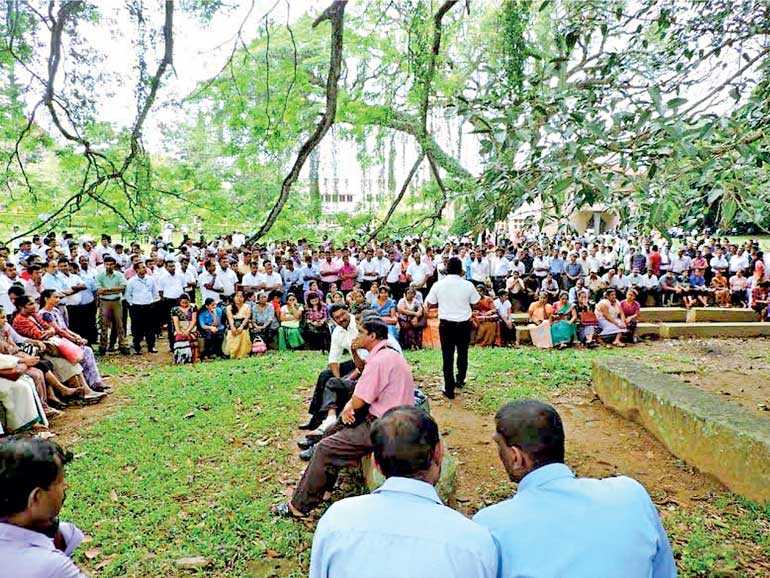Sunday Jan 11, 2026
Sunday Jan 11, 2026
Wednesday, 8 July 2020 00:00 - - {{hitsCtrl.values.hits}}

In higher education, we need to produce a graduate with the sense of belongingness. That is a must and not ‘employable graduate’ but ‘graduate with entrepreneurship skills’ needs to be produced – Pic by Shehan Gunasekara
Only two Sri Lankan universities can be seen in the list of world university rankings in the year 2020. ‘The Times Higher Education World University Rankings 2020’ includes almost 1,400 universities across 92 countries. Interestingly the University of Peradeniya has been included for the first time with a  ranking from 401-500. And University of Colombo at 1,001, which was last year in the 801-1000 category. It is important to understand what this ranking method/s is and why Sri Lankan universities are not able to position themselves into some places in rankings.
ranking from 401-500. And University of Colombo at 1,001, which was last year in the 801-1000 category. It is important to understand what this ranking method/s is and why Sri Lankan universities are not able to position themselves into some places in rankings.
What is this university ranking method/s?
It is important to note that there are several ranking methods in the world for universities. We can see QS Rankings, Times Higher Education World University Rankings and Academic Ranking of World Universities (ARWU) and many more. Each rankings use different methodologies.
QS Ranking uses six performance indicators relating to research, teaching, employability, and internationalisation. They use the following six metrics:
Academic reputation (40%)
Employer reputation (10%)
Faculty student ratio (20%)
Research citations per faculty member (20%)
Proportion of international faculty (5%)
Proportion of international students (5%)
It can be seen that the 40% weightage has been given for academic reputation which is based on an internal global academic survey. According to the intelligence unit of QS: “The QS Global Academic Survey now stands as the largest survey of its type yet on the opinions of academics globally with a response of over 100,000 for the 2021 edition of the rankings”. And research citations per faculty member and faculty-student ratio is also given prominence with 20% each. It is clear that global acceptance and research play a key role in this context.
What about Times Higher Education World University Rankings method? They use 13 performance indicators as their methodology. Refer below for further elaboration:
1. Teaching (the learning environment) – 30%
Reputation survey: 15%
Staff-to-student ratio: 4.5%
Doctorate-to-bachelor’s ratio: 2.25%
Doctorates-awarded-to-academic-staff ratio: 6%
Institutional income: 2.25%
2. Research (volume, income and reputation) – 30%
Reputation survey: 18%
Research income: 6%
Research productivity: 6%
3. Citations (research influence) – 30%
4. International outlook (staff, students, research) – 7.5%
Proportion of international students: 2.5%
Proportion of international staff: 2.5%
International collaboration: 2.5%
5. Industry income (knowledge transfer) – 2.5%
By looking at the indicators it is clear that 60% of weightage has been given for research and citations. This is the uniqueness which can be seen in Times Rankings.
Interestingly Academic Ranking of World Universities (ARWU) is using a different approach as their methodology.
ARWU uses six objective indicators that are weighted as follows:
Number of alumni who win Nobel Prizes and Fields Medals (10%)
Number of staff who win Nobel Prizes and Fields Medals (20%)
Number of highly cited researchers in 21 broad subject categories (20%)
Number of papers published in Nature and Science (20%)
Number of papers indexed in Science Citation Index-expanded and Social Sciences Citation Index (20%)
Per capita academic performance of an institution (10%)
By looking at the rankings of ARWU it is clear that the traditional weightage system has been adopted as the methodology.
If you really compare QS Rankings, Times Higher Education World University Rankings, and Academic Ranking of World Universities (ARWU) you can see they use different mechanisms as methodology. Anyway the measurements like ‘academic reputation’ is really debatable as it only reflects the reputation of given university rather than the actual performance.
Ranking of Sri Lankan universities
I have seen Sri Lankan higher authorities use Webometrics to rank universities in the past. Anyway, the Webometrics ranking is actually targeting to promote web publication. There are certain measurements that have been used in this ranking that consist of supporting Open Access initiatives, electronic access to scientific publications, and to other academic materials (Abeysekera, 2011). Nevertheless, now we can see University Grant Commission (UGC) has adopted scientific methods in ranking Sri Lankan universities.
Anyway as mentioned earlier only two Sri Lankan universities are among 1,400 universities around the globe. This is based on Times Higher Education World University Rankings. In this ranking method, 60% weightage is given for research and citations. Even if you have given perfect teaching with quality lecturing you are in trouble! I think we need to reflect on whether Sri Lankan universities are teaching or research universities.
We need to position our universities based on the competences. Some countries used their university colleges for more economic contributions with industry collaborations (they measure the performance of university by looking at how many dollars contributed per year for national income) while universities concentrating for research. And the role of university academics should be properly defined by the authorities.
There is a need to aware of the community on ranking methods and the mechanism. And I believe we need to have a holistic approach for this with the collaboration of all sectors (education as well as other industries with proper synergy). We need to see the big picture as Sri Lanka spends only 0.11% on research and development from GDP.
Conclusion
COVID-19 created a strategic window for Sri Lanka to revisit and do some radical changes for many sectors. There is a need for educational reform which is a must. In higher education, we need to produce a graduate with the sense of belongingness. That is a must and not ‘employable graduate’ but ‘graduate with entrepreneurship skills’ needs to be produced. And also there is a need for universities to define their role to position themselves in world university rankings as well.
References
Abeysekera, N (2011), http://uteachers.blogspot.com/2011/06/world-university-rankings-sri-lanka-and.html
(The writer is Professor in Management Studies at Open University of Sri Lanka. You can reach Professor Abeysekera on [email protected].)